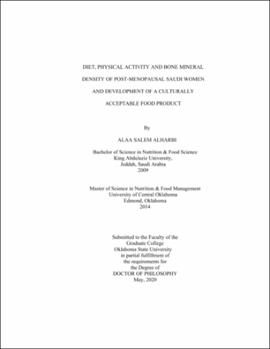| dc.contributor.advisor | Stoecker, Barbara J. | |
| dc.contributor.author | Alharbi, Alaa Salem | |
| dc.date.accessioned | 2020-09-09T21:16:22Z | |
| dc.date.available | 2020-09-09T21:16:22Z | |
| dc.date.issued | 2020-05 | |
| dc.identifier.uri | https://hdl.handle.net/11244/325478 | |
| dc.description.abstract | This study seeks to determine whether higher dietary calcium and vitamin D intakes and increased physical activity are associated with improved bone mineral density (BMD) in Saudi post-menopausal females. A total of 150 women participated in the study. Physical activity questionnaires and three-day food records were used to assess participants' daily routine activities and dietary habits. The levels of physical activity were also tracked over three days using a Letsfit watch, which counted each participant's daily steps. BMD was evaluated using a DXA scan. The findings of the study revealed high osteopenia and osteoporosis prevalence among the participants, estimated at 43.3% and 23.3%, respectively. The study also showed low sunlight exposure and low dietary intake of vitamin D in the participants. There was a positive association between BMD and the number of previous pregnancies and a negative association with the number of years after menopause. There was an observed negative association between daily vitamin D consumption and BMD. However, the result showed no associations among calcium intake, physical activity and BMD. | |
| dc.description.abstract | For centuries, cow's milk was used as a source for calcium and vitamins. However, some people have lactose intolerance or an allergy to cow milk, and they seek alternative products to avoid these health problems. The second part of this study aimed to develop gluten, dairy, and soy-free product that would be culturally acceptable in the Middle East. The product developed was entirely plant-based, with the primary ingredients being almond (25%), dates (5%), and figs (5%). Laboratory analysis was performed of the developed almond milk product and an existing commercial product, evaluating their different compositional properties. The commercial almond milk displayed higher levels of moisture, calcium, vitamin D, ash, and pH. Levels of potassium, carbohydrates, fat, sugar, and protein were higher in the developed product. A comparison between the two products was made using sensory evaluation, with the descriptive sensory evaluation showing that consumer acceptance for the developed product was higher than for the existing commercial product. However, fortification of the developed almond milk product with calcium is recommended. | |
| dc.format | application/pdf | |
| dc.language | en_US | |
| dc.rights | Copyright is held by the author who has granted the Oklahoma State University Library the non-exclusive right to share this material in its institutional repository. Contact Digital Library Services at lib-dls@okstate.edu or 405-744-9161 for the permission policy on the use, reproduction or distribution of this material. | |
| dc.title | Diet, physical activity and bone mineral density of post-menopausal Saudi women and development of a culturally acceptable food product | |
| dc.contributor.committeeMember | McGlynn, William | |
| dc.contributor.committeeMember | Ramanathan, Ranjith | |
| dc.contributor.committeeMember | Bowser, Timothy | |
| osu.filename | Alharbi_okstate_0664D_16752.pdf | |
| osu.accesstype | Open Access | |
| dc.type.genre | Dissertation | |
| dc.type.material | Text | |
| dc.subject.keywords | almond milk | |
| dc.subject.keywords | bone mineral density | |
| dc.subject.keywords | lactose intolerance | |
| dc.subject.keywords | osteoporosis | |
| dc.subject.keywords | plant-based milk alternatives | |
| dc.subject.keywords | post-menopausal saudi women | |
| thesis.degree.discipline | Food Science | |
| thesis.degree.grantor | Oklahoma State University | |
